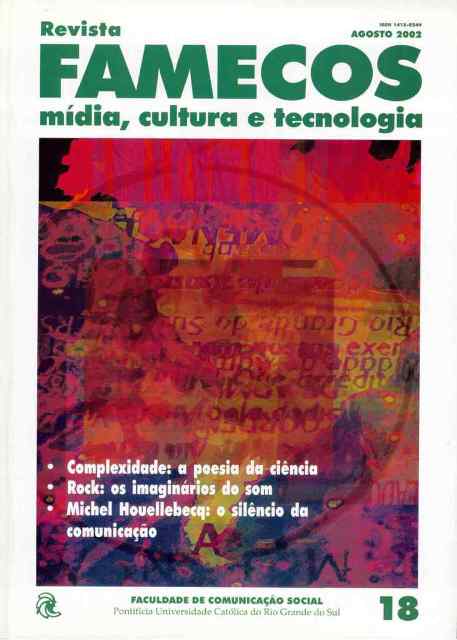Changing graphic design: instability as a rule
DOI:
https://doi.org/10.15448/1980-3729.2002.18.3177Keywords:
Communication, graphic design, modernityAbstract
This work aims at identifying and analyzing the main factors that have stimulated the appearance of a mutant graphic design. For that effect, it reflects upon the transition of Modernity to Postmodernity and upon the history of graphic design in general, specially from the Industrial Revolution onwards. The phenomenon of a mutant graphic design is identified and characterized with the help of examples which break with the habits and the rules of functionalist design of the Modernist school. The possible causes responsible for the appearance and development of a design philosophy which cultivates an unstable visual identity for graphic publications are related to social and cultural changes in contemporary society.
Downloads
References
ANN KAPLAN, E. (org.) O mal-estar no pós-modernismo. Rio de Janeiro: Jorge Zahar, 1993.
BARATA, Martins e outros. Design em aberto: uma antologia. Porto: Centro Português de Design, 1993.
BAUMAN, Zygmunt. Modernidade líquida. Rio de Janeiro: Jorge Zahar, 2001.
BUENO, Silveira. Grande dicionário etimológico e prosódico da língua portuguesa. São Paulo: Saraiva, 1965.
BLACKWELL, Lewis. The end of print: the graphic design of David Carson. San Franscisco: Chronicle Books, 1996.
CAUDURO, Flávio V. A retórica tipográfica do logocentrismo. Estudos em Design, Rio de Janeiro, v. 9, n. 1/2, p. 69-76, out. 2001.
COLLIN, Françoise. Diferença e diferendo: a questão das mulheres na filosofia. In: THÉ BAUD, Françoise. História das mulheres: o século XX. Afrontamento, Porto, v. 5, p. 315-349, 1991.
CRAINER, Stuart; DEARLOVE, Des. O livro definitivo das marcas. São Paulo: Makron Books, 2000.
CUNHA, Antônio Geraldo da. Dicionário etimológico Nova Fronteira da língua portuguesa. Rio de Janeiro: Nova Fronteira, 1986.
DEBORD, Guy. A sociedade do espetáculo. Rio de Janeiro: Contraponto, 1997.
DERRIDA, Jacques. Gramatologia. São Paulo: Perspectiva, 1973.
HALL, Stuart. A identidade cultural na pós-modernidade. Rio de Janeiro: DP&A, 1999.
HARVEY, David. A condição pós-moderna: uma pesquisa sobre as origens da mudança cultural. São Paulo: Loyola, 2000.
HELLER, Steven. Graphic style: from Victorian to Post-Modern. New York: Harry N. Abrams, 1988.
HOLLIS, Richard. Design gráfico: uma história concisa. São Paulo: Martins Fontes, 2001.
JAMESON, Fredric. Pós-Modernismo: a lógica cultural do capitalismo tardio. São Paulo: Ática, 2000.
JENCKS, Charles. What is post-modernism? Bafins Lane: Academy, 1996.
KUMAR, Krishan. Da sociedade pós-industrial à pós-moderna: novas teorias sobre o mundo contemporâneo. Rio de Janeiro: Jorge Zahar, 1997.
LATOUR, Bruno. Jamais fomos modernos. Rio de Janeiro: Ed. 34, 1994.
LESLIE, Jeremy. Nuevo diseño de revistas. México: Gustavo Gili, 2000.
LYOTARD, Jean-François. A condição pós-moderna. Rio de Janeiro: José Olympio, 1998.
MAFFESOLI, Michel. A contemplação do mundo. Porto Alegre: Artes e Ofícios, 1995.
MEGGS, Philip B. A history of graphic design. New York: John Wiley & Sons, 1998.
_______. The Politics of Style. In: BIERUT, Michel et al. Loking closer 2: critical writings on graphic design. New York: Allworth, 1997.
MOREAU, Alain. Dioniso antigo, o inatingível. In: BRUNEL, Pierre (org.) Dicionário de mitos literários. Rio de Janeiro: José Olimpyo, 1998.
Downloads
How to Cite
Issue
Section
License
Copyright
The submission of originals to Revista Famecos implies the transfer by the authors of the right for publication. Authors retain copyright and grant the journal right of first publication. If the authors wish to include the same data into another publication, they must cite Revista Famecos as the site of original publication.
Creative Commons License
Except where otherwise specified, material published in this journal is licensed under a Creative Commons Attribution 4.0 International license, which allows unrestricted use, distribution and reproduction in any medium, provided the original publication is correctly cited.






